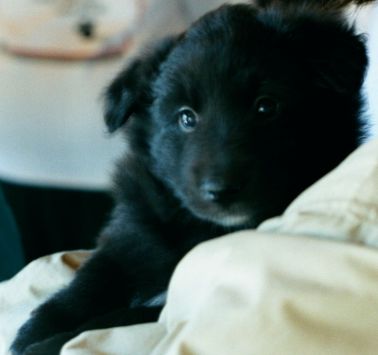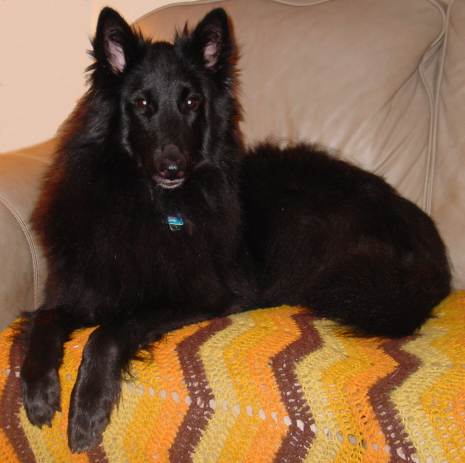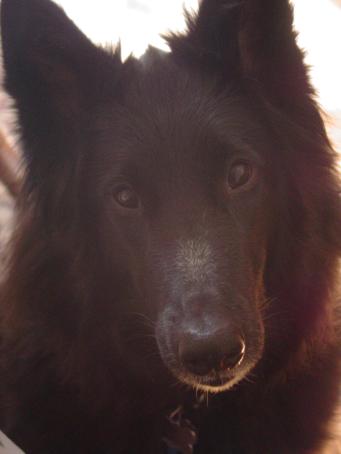

|
Born on a cold, wintery day in New Jersey, Mystic, the Belgian sheepdog, came into the world for only one reason--to have fun. Cyndi Lauper's song "Girls Just Want to Have Fun" could have been written for her. Beneath her silky black coat, she was really very intelligent. She simply chose not to show it, and we often joked that she should have been born blonde.
When her litter was five-weeks old, we traveled from Virginia to New Jersey to see the seven puppies. Upon our arrival, the breeder shoved a puppy into my arms. At that moment, I should have known that "white girl" was special. She struggled to be free of my restraint, so she could explore the puppy room. As soon as her tiny paws made contact with the floor, she charged ahead and led the litter into new worlds of mischief. I thought she was headstrong, and felt some sympathy for the family who eventually adopted her, knowing they would certainly have their hands full keeping her contained.
At seven weeks, the puppies were temperament tested. We received a call from the breeder. Yes, fate had intervened--white girl was ours. The entire family groaned with the news, expecting to have a little hellion on our hands. Soon afterward, we met the breeder's sister at her home in Richmond and brought our little girl home. I quickly learned that I had been mistaken. She wasn't headstrong. Instead, she was a puppy who enjoyed life to the fullest. Being the largest puppy in the litter, she merely had the advantage of scaling puppy barriers sooner than the rest.
 |
Once in her new home, she met our other Belgian sheepdog Magic and our crossbreed Isabella. Immediately, she identified with Magic and began following him around. Up to that point in time, Magic had loved puppies, but he decided that one living in the same household with him was another story. A week passed before we thought of the appropriate name for white girl, and of course, that was Mystic.
Over the years, we've had numerous puppies, but none of them were as fun loving or toy-oriented as Mystic. At the same time, she was gentle and never eviscerated a stuffed toy like Isabella had. Even though Magic still considered her a bit of a nuisance in a kid sister fashion, he tussled with Mystic often. Other times, she was left barking on the periphery when the two larger dogs rough-and-tumbled just a little too much for her liking.
As might be expected of a Belgian, she learned quickly. During the summer, she graduated from basic obedience. When classes were almost over, we decided to take the Belgians with us on a vacation in downeast Maine. Magic hates to vary his routine, but on our way to Maine, we stopped off to visit with friends, including Mystic's breeder in New Jersey. While there, we visited another friend who has greyhounds. Mystic quickly discovered that greyhounds were delightful to have around. Besides, Magic liked them too, so they had to be okay. The cat in the household was another story. Rugby had a mean look in his eyes that Mystic presumed could only signify he might make a meal of a Belgian puppy.
 |
After our visit, we traveled on to Maine, where Mystic happily explored beaches, trails, and rocks. Nothing fazed her. Yet, all this time, we were careful not to overdo the hikes, so as not to stress her growing puppy joints.
Upon our return, we continued taking Mystic places by hiking the Virginia battlefields and Shenandoah National Park. As she grew, the distances got longer. In the fall, she returned to obedience classes for the second level. Now an adolescent with a mind of her own, she showed a stubborn streak. While she easily mastered the exercises, they were to her own unique specifications. Stays were something that she especially had difficulty with and often ignored. On the final night of class, we participated in a fun exercise, and she had the fastest "front" of all the dogs.
 |
Winter brought more hiking and sledding in the snow with our son Bryan. She looked particularly ready for the weather when wearing his scarf. Royal blue was her color and set off her glossy black coat. But as time went on, Mystic changed. The transformation was so gradual that the signs were barely noticeable, and we dismissed them to the fact that she was growing up.
Looking back, we should have realized that an active dog like Mystic doesn't slow down until well into old age. Her obsession with toys faded completely, and she had an unusual way of playing Frisbee. Instead of being tossed into the air, the disk was spun rolling on the ground and more resembled something a lure-coursing sighthound would chase. Little did we know these seemingly harmless quirks were likely due to the fact that she must have been in constant pain.
In the summer of 2003, the family traveled to England and Ireland, making it necessary to kennel the dogs while we were away. Upon our return, Mystic developed a bladder infection. A round of antibiotics easily solved the problem, but it was an ominous sign of things to come.
 |
As the months went by, the shape of Mystic's nose gradually grew distorted. Never having seen anything like it before, my vet was totally perplexed. A physical exam revealed the cause behind the disfigurement as numerous lumps on her face. In October, she underwent a biopsy. We breathed a sigh of relief when the results were non-cancerous. Instead, they seemed to be infectious in nature, and a dermatologist was recommended.
The dermatologist had seen other cases like Mystic and diagnosed the lumps as nodular granulomatous dermatosis. An intensive regimen of tetracycline and niacinamide was prescribed with a warning that if the condition turned out to be autoimmune in origin, a more aggressive treatment would be required. While being treated, she lost weight, but after several months, the lumps vanished. In the summer of the following year, her dosage was reduced.
Soon after, a cloudy-white film formed on her eyes. At first, I dismissed it to poor lighting. At a visit to the dermatologist, the white film was confirmed as something on her corneas. The dermatologist searched for the resident ophthalmologist, but he was "out" that day. Mystic's condition was now highly suspect of being an autoimmune disorder. During a regular veterinary visit, the opaque veil was reconfirmed. A traveling ophthalmologist was recommended.
For various reasons, the ophthalmologist took a couple of months to schedule an appointment. I asked for another recommendation, since we had dealt with immune-mediated diseases several years before with our husky Chinook. If Mystic also suffered from such a condition, I wanted her to get proper treatment immediately.
Mystic also began showing signs of arthritis. Sometimes the pain was so intense, she would literally scream. More than one veterinarian examined her and found nothing wrong. Now, I believe her nerves must have also been affected. The original ophthalmologist made her rounds before I was able to get an appointment with another.
The weekend before her eye appointment, Mystic had another arthritic flare. Bloodwork was taken at the same time her eyes were examined. The ophthalmologist diagnosed her eye problem as nodular granulomatous episcleritis and felt it was immune-mediated. At that time, Mystic's condition wasn't considered serious. We were told not to worry unless the cloudiness got worse. Meanwhile, the tests on her bloodwork came back as positive for Lyme Disease and Ehrlichiosis. Specialists were consulted, and each felt that since her affliction was under control she should continue with her current regimen.
In March 2005, Mystic was examined by the dermatologist for the last time. He hadn't received a copy of the ophthalmologist's report, but he felt everything looked good. We were instructed to continue tapering her medication, leaving a safety interval between each reduction. Because she had an arthritic flare earlier in the week, he also examined her joints, but again found nothing wrong.
By June, Mystic was medication free. Almost immediately, her symptoms got worse. Her right eye grew cloudier, and the arthritis returned with a vengeance. She hobbled around the house like a fourteen-year-old dog, rather than a four-year old. A round of x-rays indicated that her hips were in good shape. She had no degenerative joint disease. Finally, my regular vet also believed we were dealing with an autoimmune disease, yet when he consulted with a specialist at the local vet school, he was told that infections needed to be ruled out before treating for immune-mediated problems. They felt the Lyme and Ehrlichia bacteria had probably never been eradicated from her body.
Doxycyline (another form of tetracycline) was prescribed. Almost instantly, Mystic was bounding around the house like a four-year old again. But all was not well. On the hottest day of the year, she started drinking a lot of water. Due to the heat, we thought nothing of it. That same night, I found her lying in the bathroom. Again, even though she didn't normally go into the bathroom, I dismissed her behavior to the heat.
In the morning, Mystic failed to come when the other dogs went outside. My husband checked in the basement because she often retreated to the coolest place in the house during the summer. She was huddled on the floor and didn't want to go outside. He finally coaxed her. When he went into the bathroom, there was a pool of dark blood on the floor.
Immediately, I got dressed and rushed her to the vet. Even though she was weak, she briefly climbed onto the passenger seat to look out—a pastime that she always enjoyed. At the vet, I received the news that she was bleeding internally, but they were unable to determine from where. I then personally delivered her bloodwork to the hospital, and hoped for the best. At noon, I received a call from the veterinarian, asking me if I could deliver Mystic to an emergency clinic an hour and a half away near Richmond. She was still bleeding, and they couldn't locate the source.
I took Mystic to Richmond for her last car ride. She was far too weak to sit on the seat. Upon arrival at the clinic, she had a little more energy than earlier in the morning, and I could see a light in her eyes again. The emergency vet diagnosed that her bleeding was in the upper gastrointestinal tract. He also found effusion [excessive fluid] in her joints. He said that we could be dealing with rheumatoid arthritis and/or lupus.
When I left the clinic, Mystic didn't want to stay behind. The following morning, I called the clinic. She was doing better. In the afternoon, the vet called. She had stopped bleeding and had even eaten. We looked forward to bringing her home in a couple of days.

|
Note: the white patch on Mystic's nose visible in this photograph is where she had excoriation (loss of hair); her hair eventually grew back as seen rather than all black. Also, the lightness visible in her right eye (on the left of the picture) is predominantly due to the corneal problem (see above). What you see in her left eye is mostly reflection from ambient light. |
That night, she began bleeding again. I stopped by the clinic to see her the next afternoon. While she walked under her own power, she was an empty shell. She didn't even recognize me. When Chinook had given up and nearly died, I knew he could get better. He did. With Mystic, I only felt emptiness. Maybe she felt that she could no longer have fun. Her essence was already gone, so I let her body go.
True to her name, she will remain a mystery, but looking back, I can fit some of the puzzle pieces together. The vets discussing back and forth whether her condition was infectious or autoimmune is like the chicken and the egg. The Lyme/ehrlichia infection most likely kicked in her immune-mediated condition. An autoimmune panel ruled out lupus and rheumatoid arthritis. Ehrlichiosis is known to cause fatal bleeding in some dogs. It is also known as the silent killer.
An article on ehrlichiosis with the foreword written by Dr. Ibulaimu Kakoma DVM PhD, one of the leading specialists on ehrlichiosis, has this to say, "Any patient positive in the IFA [Indirect fluorescent antibody--detection of antigen or antibody using antibodies labeled with a fluorescent dye ] and presenting with signs consistent with ehrlichiosis should definitely be treated." The article also states, "There are many cases where a dog's CBC [complete blood count] has been 'within normal limits' yet the dog died of ehrlichiosis"! Mystic's CBCs were often "normal" yet on several occasions they varied from the norm just enough that veterinarians took the time to make note of it on her chart.
I only know that I miss my little girl. The night after she died, I had a dream. Mystic was lying upside down. For those who don't know Belgians, this is a common sleeping position. It means contentment. Released from a pain-ridden body, she has probably found a way to have fun again.
For those who are interested in learning more about tick-born diseases, there is a mailing list that may be of interest. To subscribe, send a message:
To: listserv@apple.ease.lsoft.com(you) |
In other words, send an e-mail with subscribe
tick-l in the body of the message, to the listserv address
shown above.
The text in this web document ("page") is Copyright © 2005 by Kim Murphy, and the images are Copyright 2005 by Kim and Pat Murphy; all rights reserved. This page, or any part of it, may not be reproduced in any form, electronic, print, or otherwise, without the prior written or emailed consent of the owners. This includes mailing lists, web sites, usenet newsgroups, bulletin boards, blogs, etc.